Main Elements of a Creative Brief
Creative briefs should include sections detailing the campaign’s goals, deliverables, style, and target audience. The brief will also have information about the brand and competition in the marketplace.
A project manager for the team requesting the content or a member of the marketing or advertising team will write a creative brief. The specific sections of a creative brief might vary depending on the project and its stakeholders, but keep these eight main elements in mind:
- Brand Identity and Project Overview: The first section of the creative brief provides relevant background information about the brand’s mission and the campaign’s purpose, whether it is responding to pain points or advertising a new product. Summarizing these key details at the outset gives the creative team a focused direction and ensures the campaign fits into the overarching brand identity.
- Objectives: Clearly define goals and be sure to link them to key performance indicators (KPIs). Using SMART (specific, measurable, achievable, relevant, time-bound) goals when crafting objectives help you focus on the project and key metrics.
- Competitive Analysis: Reviewing examples of recent campaigns from rival brands is a valuable strategy when seeking insight for a creative brief. Analyzing competitors’ strengths and weaknesses sheds light on what resonates with consumers and how to make a campaign stand out in the market.
- Target Audience: Creative briefs should boil down which segment of the brand’s audience the campaign will target. Specific demographic profiles help the creative team understand customer behaviors and deliver the most effective and appealing assets.
- Tone and Style: Whether defining a personality, listing adjectives that correspond with the core message, or designating a color palette, the creative brief clarifies the attitude and visual identity of the campaign. Designers need direction on the desired voice and style to ensure a unified final project that speaks to the target audience.
- Content Format and Deliverables: Every creative brief must outline the specific content that the creative team needs to produce, such as social media assets, print advertisements, graphics, video content, online copy, or other elements of the campaign strategy. Include any format requirements or other specifications, so that the creative team can align their output with the campaign objectives.
- Timeline and Budget: Stipulating key deadlines, checkpoints, and budget requirements enables the creative team to deliver on target. This information is crucial when working with external agencies, for whom the brief can function like a contract. Concrete schedule parameters give project managers details that they can follow up, warding off scope creep. Learn how to manage scope creep and keep projects on track.
- Stakeholders: Briefs should include the contact details and roles for all the team members who will be involved in the project. Establishing individual responsibilities and review processes ensures internal and external stakeholders can communicate seamlessly throughout the process.
How to Write a Creative Brief
Writing a creative brief starts with gathering the information that will guide a campaign’s direction. Begin with a focused overview of the project and include concrete details on your objectives, audience, and deliverables.
A strong creative brief is clear, specific, and short. Think of it as a blueprint to inspire creativity and keep your team on track from ideation through delivery and execution. Consider using creative brief templates to save time and maintain consistency across multiple projects. For branding campaigns or launches, a more specialized brand brief might be necessary.
1. Gather Information and Resources
Before you start writing, do the prep work for your brief. This might include researching competitors, analyzing pain points, meeting with stakeholders, and referencing past campaigns. Use this information to finalize your core message, target audience, and objectives.
Once you have a clear idea of the campaign, gather the necessary supporting documents. Compile links to important resources, such as a brand style guide, digital asset library, and any example content for the creative team to reference.
2. Decide What to Include
The details of the campaign, stakeholders, and objectives will determine which elements of the creative brief are necessary. For example, internal team members might not need comprehensive information about your brand mission. Or you might include a budget for advertising campaigns, but not for designing a new website banner.
Keep in mind that the creative brief should be concise and focus on the creative direction of the campaign. If you need to determine a comprehensive marketing and distribution strategy, consider completing a marketing strategy brief first.
3. Name the Campaign and Write an Overview
Naming the project is a simple first step to streamline communication. The campaign name should point to its core message — the idea, consumer benefit, or call to action (CTA) — the creative team needs to get across with their assets.
Start by writing an overview that defines the core message in a few sentences. Consider including relevant brand identity aspects or drafting a short section with brand and product background. Establish why you are launching this campaign, the opportunities or challenges, and the takeaways for your audience.

“For example, in our creative brief for a new rug collection launch, we highlighted our rugs’ unique designs inspired by Southwestern traditions and their high-quality sustainable materials. Conveying these key points up front allows designers and copywriters to center their creativity around the communication of these distinguishing factors,” offers Connor Butterworth, CEO and Owner of Southwestern Rugs Depot.
4. Set Clear Objectives
Highlight one or two goals for the campaign that align with its core message. Be sure to define the KPIs you will use to measure success. Common campaign objectives include boosting engagement, increasing conversions, and communicating a specific call to action or desired consumer behavior.

5. Analyze the Competition
Survey the competitive landscape for real-world models. Focus on a few major competitors and provide examples of their recent campaigns for similar products. Highlight key successes and failures to learn from, and create a list of the ways in which your brand or product differs.

Elaine Chen, Founder of marketing consultancy Excogita, advises, “Creatives understand that not every project will immediately hit the mark, but they need feedback to get to the right place. Spend time looking at competing campaigns so that you have concrete ideas about what you feel will and won't work, and share some of these insights in your brief.”
6. Define the Demographic
Determine a primary target audience for the campaign. Are you trying to reach a segment of the current brand audience or potential new customers? Break down your target audience with demographic data — such as age, gender, and geographic location — as well as buying behaviors and psychographic information, such as preferences and interests.
Instead of listing all the aspects of your target audience, use profiles or personas to draw a precise portrait of your customer in a couple sentences. Learn how to create customer profiles to better understand your audience with individualized buyer personas.

7. Explain the Tone
Choose several adjectives that describe an attitude or personality for the campaign. Align this personality with the key message, cater it to your target audience, and fit it within your brand identity. Include links to any brand style guidelines or designated fonts and color palettes.
Should graphics feel sophisticated and minimalistic or playful and energetic? Is the tone authentic and empowering or confident and provocative? The adjectives you choose will guide both the visual direction and voice of your campaign, keeping all the elements of the project cohesive.
8. Designate Deliverables
Determine what assets or content the creative team needs to produce to meet the campaign objectives. Specify the content format, the number of deliverables, and any requirements or specifications, such as image dimensions or character limits. You might mention your distribution strategy if modified versions of the assets will be needed for different platforms.
9. Walk Through the Timeline and Budget
Working backward from the campaign launch date, determine when assets need to be delivered in order to be reviewed by key stakeholders and released on schedule. Fill in important due dates, review periods, meetings, and final approval deadlines leading up to the release date. If the creative team will be producing video content or multichannel advertising campaigns, establish a budget.
10. Present to Stakeholders
Share the completed brief with all the stakeholders involved, from the creatives who will be producing the content to the executives who will approve final designs. The creative team might consist of in-house designers and marketers, or it could be an external agency. Consider including a project manager to track deadlines and deliverables. Project managers can create a separate project brief to summarize high-level details.
Whether you present the brief at a project kickoff meeting or distribute it electronically, be open to feedback. The creative team might have questions on the timeline, resources, tone, or approval process. The marketing director could help you fine-tune the target audience and core message. Refine the brief if necessary before you share the final version. Make sure everyone understands the direction of the project and their responsibilities.
Video: How to Use AI to Write a Creative Brief

Examples of Creative Briefs
These creative brief examples use variations on the basic creative brief template to communicate specific project details to stakeholders. These downloadable and customizable templates include example copy for a variety of creative brief scenarios.
Simple Creative Brief Example Template
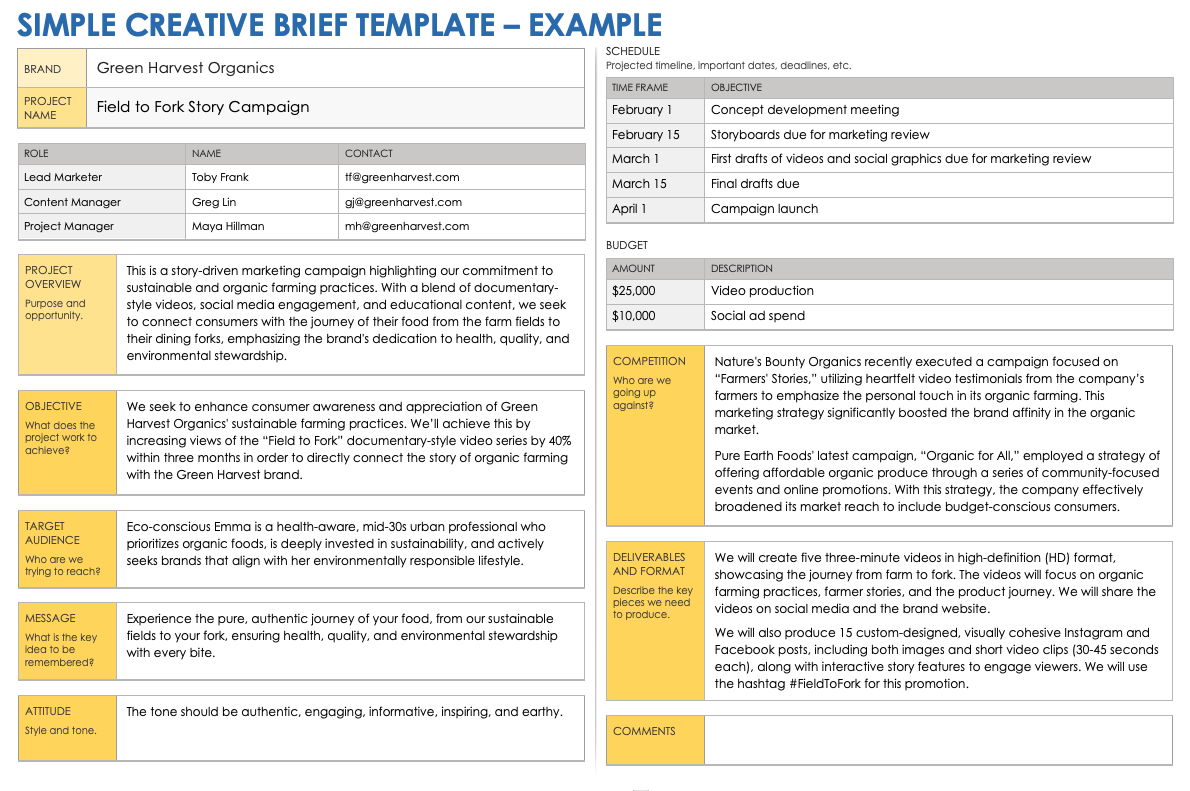
Download the Simple Creative Brief Example Template for Microsoft Word
Download the Simple Creative Brief Blank Template for Microsoft Word
Here’s an example of a creative brief for a marketing campaign designed in-house. This short creative brief template keeps a tight focus on the project itself — and doesn’t waste time providing unnecessary context.
Client Creative Brief Example Template
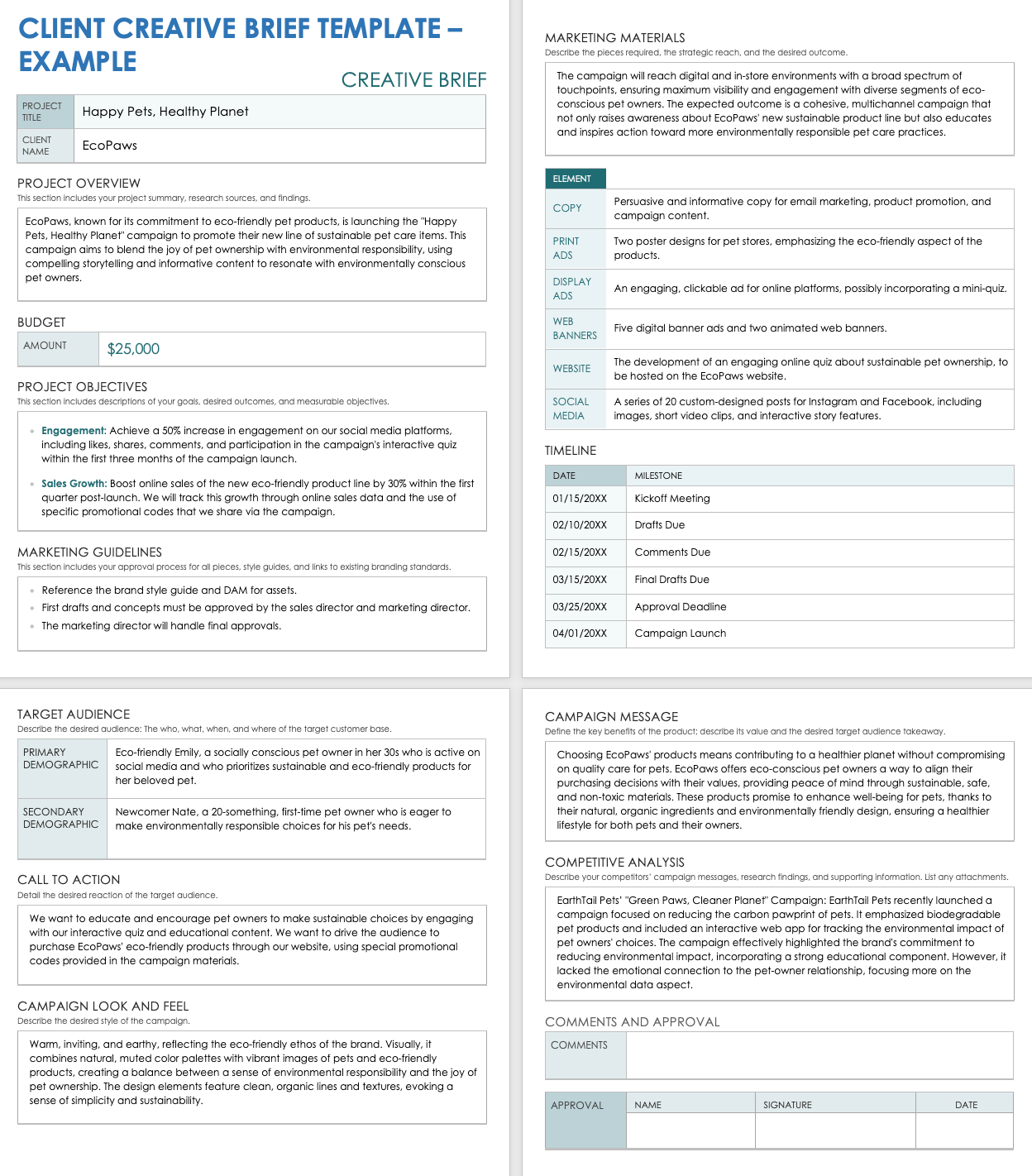
Download the Client Creative Brief Example Template for Microsoft Word
Download the Client Creative Brief Blank Template for Microsoft Word
This example shows how a creative brief might be completed for implementing a marketing campaign with an agency. There is more information about the client — the brand, project message, and call to action — while leaving room for the creative team to innovate.
Graphic Design Creative Brief Example Template
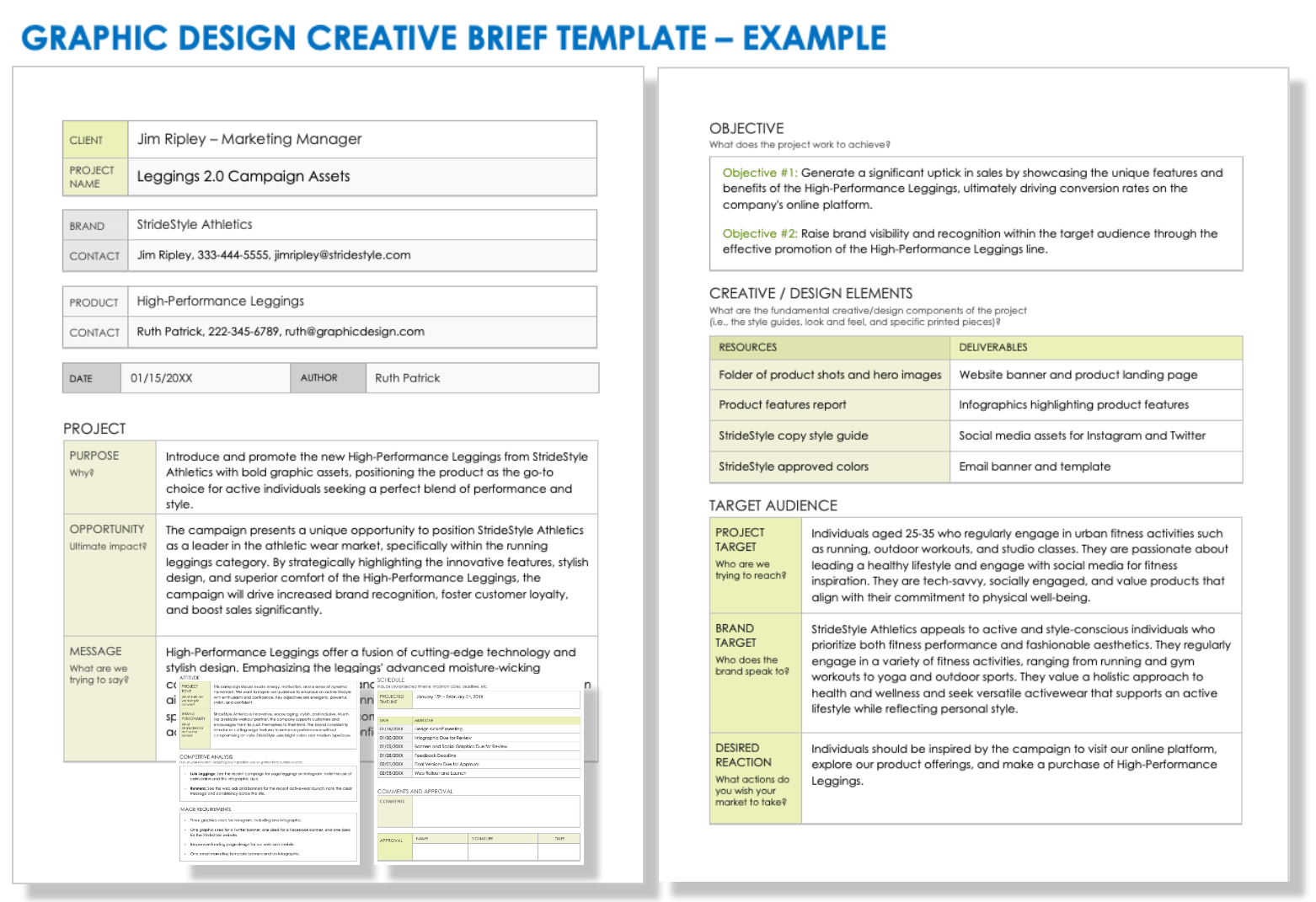
Download the Graphic Design Creative Brief Example Template for Microsoft Word
Download the Graphic Design Creative Brief Blank Template for Microsoft Word
Here’s an example of a creative brief for a graphic design project that is perfect for solo graphic designers or graphic design firms planning projects in collaboration with their clients. The simple, adaptable layout has room for details on image requirements and design elements, as well as direction about the project.
For more elaborate design projects — such as a logo design or product design — consider using a specific design brief.
Advertising Creative Brief Example Template
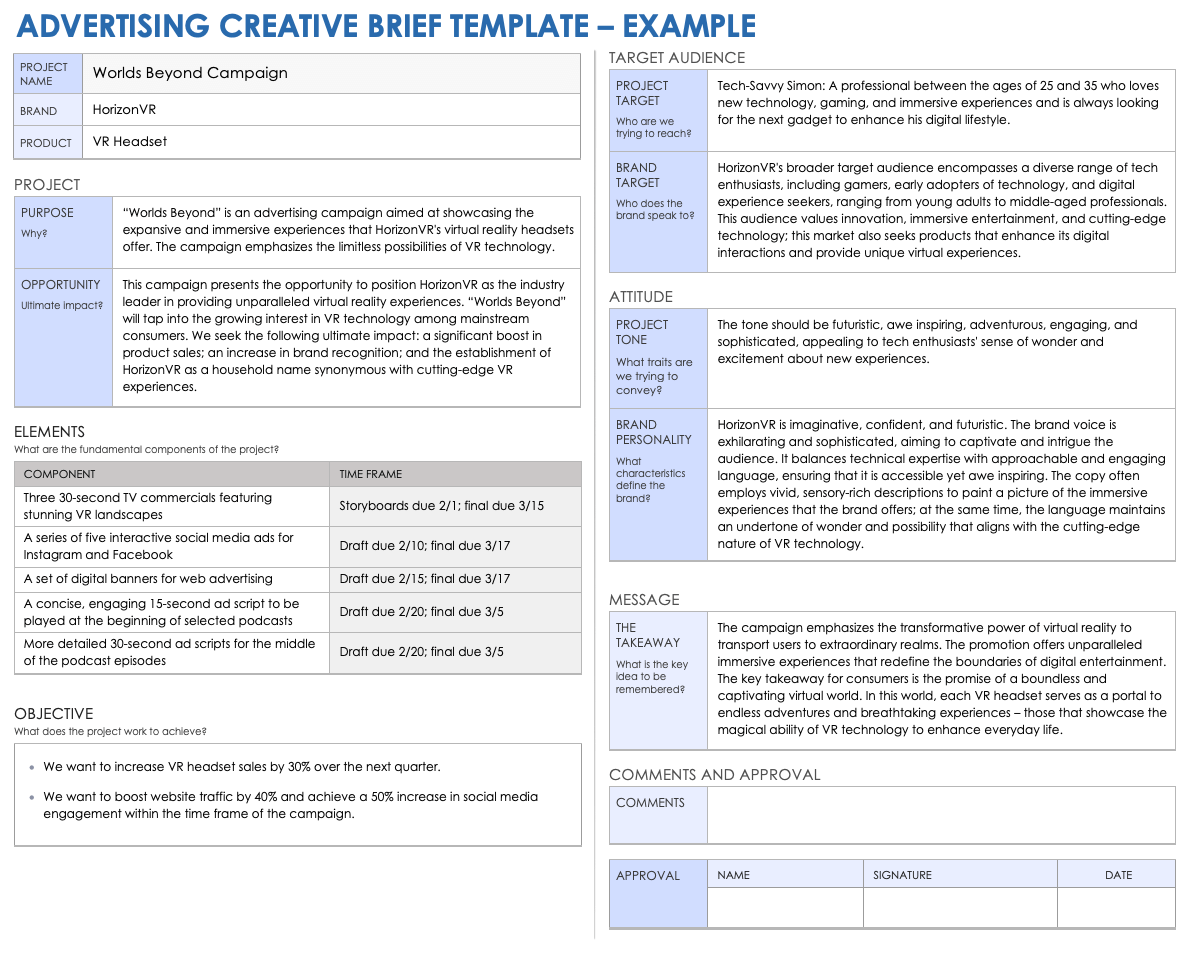
Download the Advertising Creative Brief Example Template for Microsoft Word
Download the Advertising Creative Brief Blank Template for Microsoft Word
This creative brief example uses a straightforward advertising campaign template to cover objective, tone, messaging, target audience, and non-negotiables. There are also key advertising elements needed for the campaign.
What to Keep in Mind When Writing a Creative Brief for Internal Use vs. an Agency
Creative briefs are a campaign’s starting point for both in-house teams and agencies. The project’s stakeholders will determine the brief’s content. Both internal and external creative teams need information about the campaign’s message, but agencies might need more brand details.
Internal creative briefs are often short and direct, since the stakeholders will bring their understanding of the brand and its identity to the project. Internal creative teams might already be familiar with style guidelines, recent campaigns, and customer personas. It’s still important to include focused direction specific to the campaign objectives, but the brief can be more informal and flexible.

Creative briefs shared with external agencies, on the other hand, are often more extensive. CEO and Founder of Awning.com Shri Ganeshram recommends crafting a “more detailed and structured brief” when working with an agency. “It has to convey the essence of your brand and project requirements without any assumed knowledge,” he continues. “When I worked with an external design agency for our marketing campaign, the detailed brief we provided helped them grasp our brand ethos quickly, resulting in a highly successful campaign.”
As a marketing executive with both in-house and agency experience, Chen points out that projects that are contracted out might also require more comprehensive briefs. “Many companies are only working with agencies on high-profile or very strategic assignments such as major advertising campaigns, creating new brands, or significant rebrands. Accordingly, the briefs will need to include lots of insights about the product and audience, while avoiding being too prescriptive to give the agency room to innovate.”
Additionally, while both internal and agency creative briefs typically include deliverables and deadlines, these stipulations might carry more weight externally. In his experience working with agencies, Ganeshram explains, “The creative brief acts as a contract of sorts that outlines what the client expects, providing a clear framework within which the agency operates. This distinction is crucial for ensuring both parties have aligned expectations.”
Pitfalls to Avoid When Writing a Creative Brief
An effective creative brief empowers designers, advertisers, or marketers to deliver original and compelling content. On the other hand, vague or complicated briefs make it impossible for creative teams to meet expectations. Avoiding these pitfalls streamlines the creative process.
There are five common pitfalls to keep in mind when writing creative briefs:
Ambiguity:

A vague direction can make it impossible for the creative team to understand the vision for the campaign. Provide specific information about the tone and message, as well as clear guidelines for the format of the final product. “If you leave anything up for interpretation, then you risk the result not being what you expected,” advises Kristien Matelski, Content/PR Manager at Vizion Interactive. “I’ve found that a few good examples are much more valuable than just describing what I’m looking for.”- Overprescription: Conversely, including too much detail can limit creativity and overwhelm the core message. Designers, copywriters, and other creatives need freedom to bring their own expertise and imagination to the project. “While detailed background information is always helpful, realize that you can only convey so much in a single communication,” Chen notes. “Avoid requiring your creative team to fold in too many messages or else you could end up with a garbled mess.”
- Broad or Unspecified Audience: It’s crucial to define a target audience with as much detail as possible. Large campaigns might have primary and secondary markets, but to create effective assets, the team needs to have a specific audience in mind and understand their behaviors. “Too often companies are so focused on what they have to say that they end up failing to incorporate customer perspectives and create a message that just falls flat,” cautions Chen.
- Unrealistic Expectations: The purpose of a creative brief is to keep stakeholders’ expectations and responsibilities aligned throughout the project’s development. However, if the brief sets impossibly tight deadlines or unattainable objectives, creatives won’t be able to deliver compelling results.
- Complicated CTA: Campaigns work best with a simple and clear core message or desired outcome. Creative briefs that fail to develop a clear call to action result in campaigns that can’t meet their objectives. Chen adds, “It's most realistic to ask consumers to do just one easy thing after seeing your ads. A complicated, multistep process or a confusing mix of options is doomed to fail.”
Expert Tips for Using Generative AI
Recent advancements in generative AI have made it a powerful tool for crafting creative briefs. AI can analyze pain points and customer data, suggest relevant core messages, and elevate directions on tone and style. Think of the AI as a partner or assistant when drafting your prompts, and be prepared to finetune the results.
“Generative AI can be a game-changer for crafting creative briefs in marketing and advertising,” observes Peter Wood, CTO at Spectrum Search. “It's essential to leverage AI for initial idea generation. By feeding the AI system with your campaign’s objectives and target audience demographics, you can get a diverse range of creative concepts and narratives, which might not be immediately obvious to a human team.”
You can also use AI to assist in data analysis when researching your competitors and establishing customer personas. Wood continues, “This analysis can inform the tone, style, and content of your brief, ensuring it is aligned with what resonates with your audience.”

“As a content manager, I’ve found that creative briefs have been a primary use for AI,” reveals Kristien Matelski. To get the best results from the AI, she recommends providing it with background information about your brand and objectives, as well as detailed instructions for the content you want it to generate. Keep revising and updating your prompts as you work, and make sure to verify any facts or data in your results.
Here are four tips to keep in mind when utilizing AI to draft your creative brief:
- Pretend the AI Is Your Assistant: AI is not a search engine, and it can handle more complex directions. “Be as detailed as possible with what you want, like you’re giving instructions to an assistant to write a brief or outline for you,” suggests Matelski.
- Provide Background: Feed the AI relevant information about the brand, product, or campaign objectives. Matelski says, “I generally start by giving the AI some context about the who, or the company we are generating a creative brief for, including a link to their website. Then I tell it the what that we’re creating, a creative brief or outline for a new product page.”
- Include Specifics: If you are using a template, make sure to list the fields you want the AI to generate. Establish any requirements and important campaign directives to include in the brief. As an example, Matelski offers, “Be sure to mention X, Y, Z brand names, color choices, and keywords.”
- Edit, Edit, Edit: Once the AI has generated the brief, read through the results and determine next steps. “You’ll need to edit yourself or go back and forth with the AI a few times to get it how you want it,” Matelski acknowledges. You might ask the AI to condense the overview, suggest a more playful core message, narrow the objectives, or tailor the deliverables for a specific social media platform. Consider whether you need to provide additional information with your instructions.
Cheat Sheet for Generative AI Prompts with Example
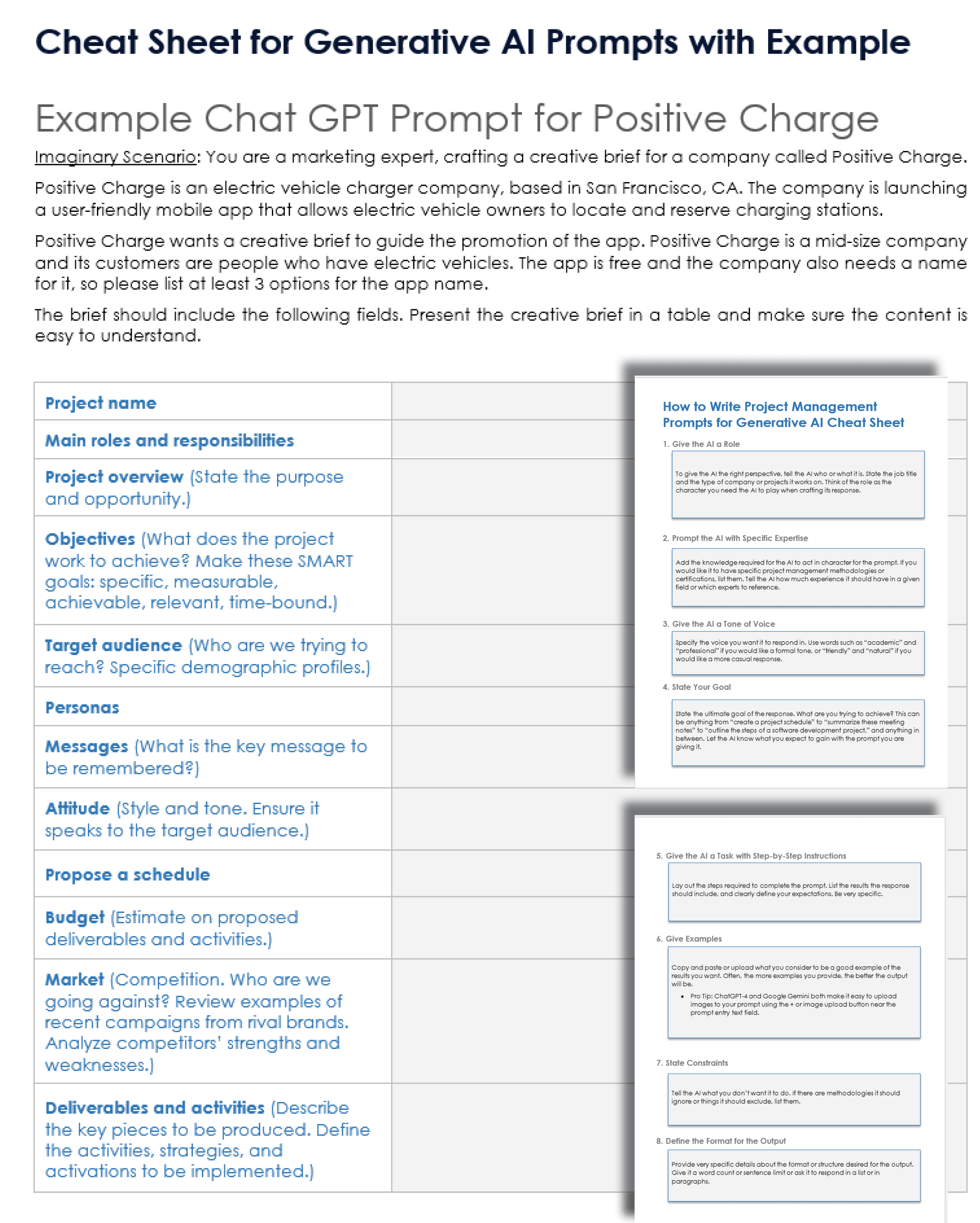
Download a Cheat Sheet for Generative AI Prompts with Example for Adobe PDF
This cheat sheet will help you write more effective prompts when using generative AI tools. You'll also find an example of how to write an AI prompt to generate copy for a creative brief.
Improve Your Creative Briefs with Smartsheet for Marketing
The best marketing teams know the importance of effective campaign management, consistent creative operations, and powerful event logistics -- and Smartsheet helps you deliver on all three so you can be more effective and achieve more.
The Smartsheet platform makes it easy to plan, capture, manage, and report on work from anywhere, helping your team be more effective and get more done. Report on key metrics and get real-time visibility into work as it happens with roll-up reports, dashboards, and automated workflows built to keep your team connected and informed.
When teams have clarity into the work getting done, there’s no telling how much more they can accomplish in the same amount of time. Try Smartsheet for free, today.